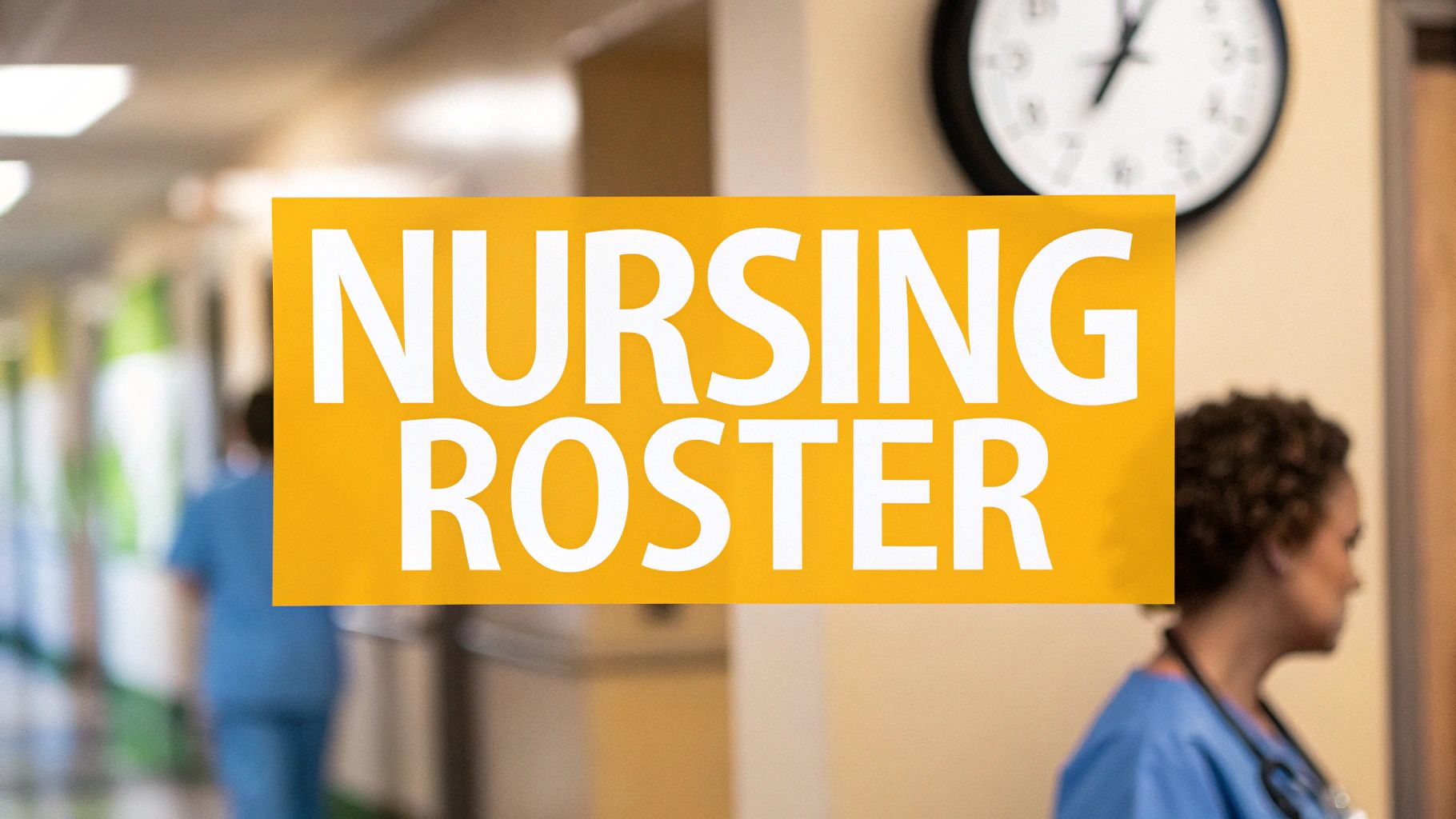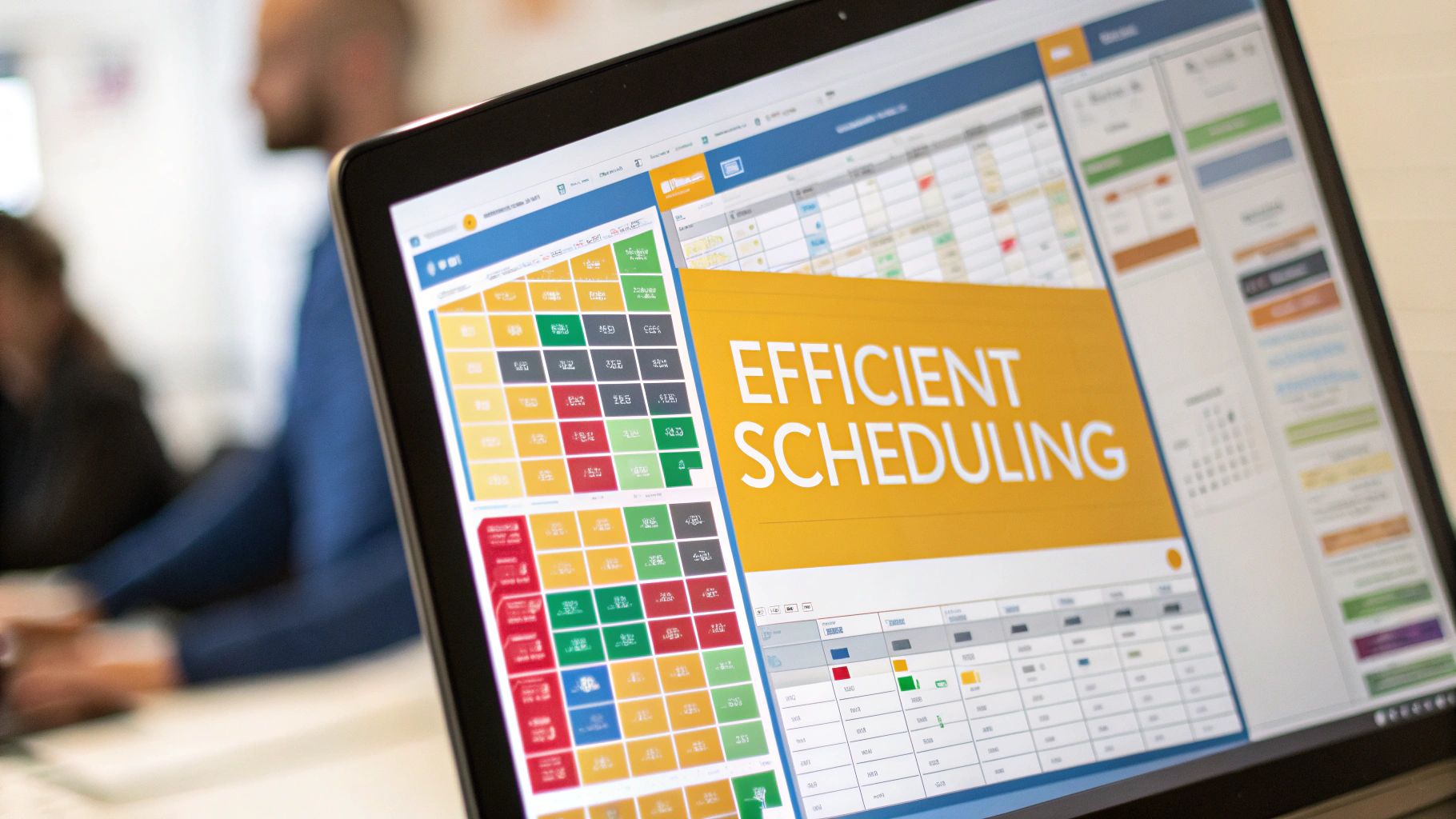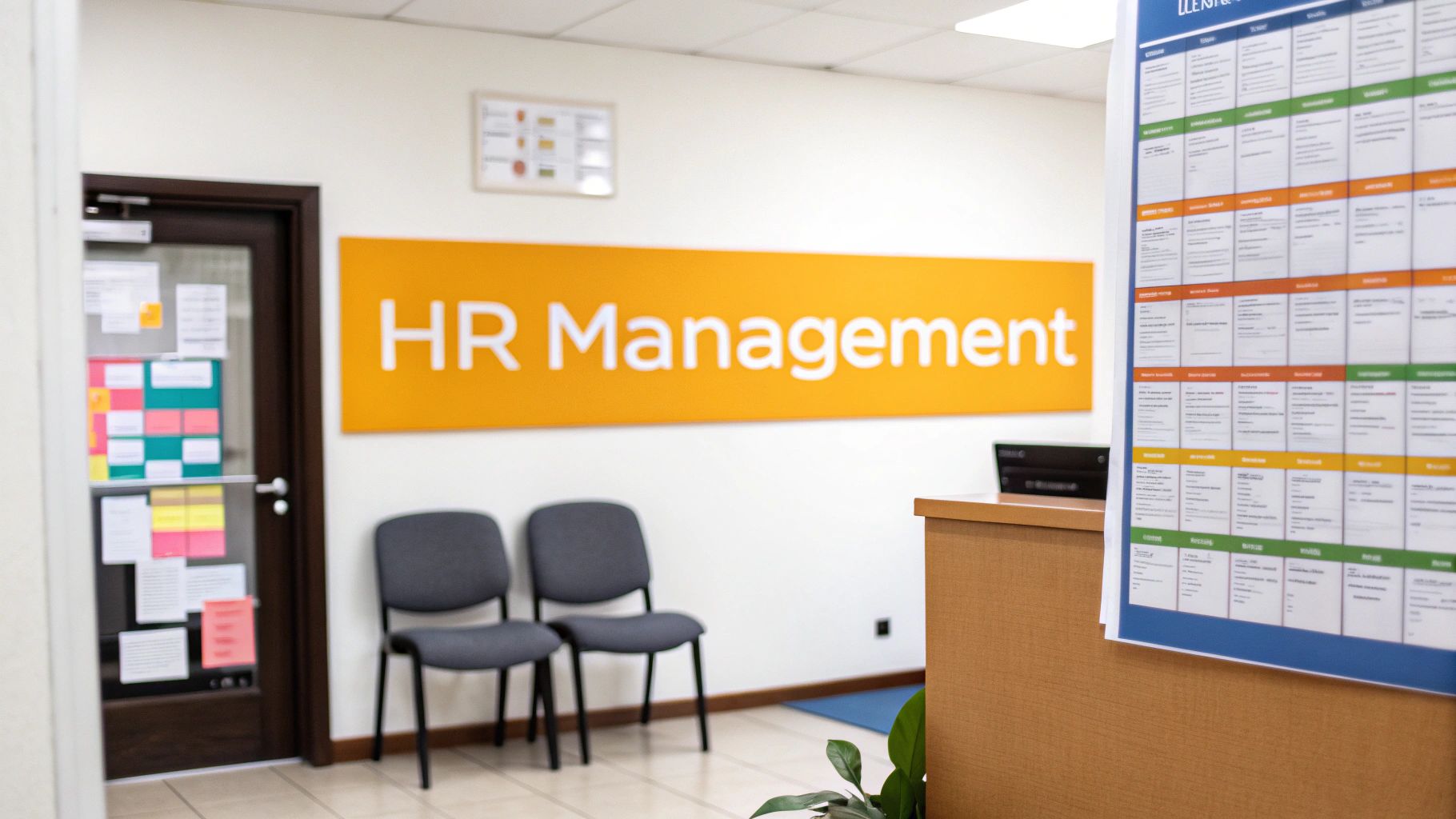From our resource library for organizational scheduling and management.
The Complete Guide to Nursing Roster Software: How Modern Solutions Are Transforming Healthcare

The Evolution And Impact Of Modern Roster Solutions
The way healthcare facilities handle staff scheduling has changed dramatically in recent years. Gone are the days of marker boards, endless calls, and schedule mix-ups. Modern nursing roster software has brought welcome relief through centralized, automated systems that give nurses more time to focus on what matters most - caring for patients.
From Manual to Automated: A Transformation in Scheduling
The old way of creating staff schedules was time-consuming and error-prone. Managers struggled with understaffing, overstaffing, and unhappy staff members due to schedule conflicts and last-minute changes. Today's nursing roster software eliminates these headaches through automation. By handling the complex puzzle of staff scheduling automatically, these systems help ensure appropriate coverage while keeping staff satisfied.
The Rise of AI-Powered Solutions
The newest roster solutions now include artificial intelligence (AI) and machine learning capabilities that make scheduling even smarter. One key feature is predictive staffing - analyzing past data to forecast future needs. For instance, hospitals can prepare for seasonal patient increases by adjusting staff levels ahead of time. These AI systems also match staff skills and availability to patient needs, ensuring the right care team is always in place.
A Growing Market Driven by Innovation
More healthcare facilities are adopting these advanced scheduling tools each year. The market size reached USD 318.48 million in 2023 and is expected to grow to USD 982.3 million by 2031 at a CAGR of 13.4%. These numbers, reported by Verified Market Research, show how much healthcare organizations value better staff management tools. The growth reflects a fundamental shift in how facilities approach workforce planning.
Impact on Staff Satisfaction and Patient Care
Better scheduling does more than just save time - it improves the entire healthcare environment. When nurses have more control over their schedules and fewer last-minute changes, job satisfaction increases. This leads to less stress and burnout, allowing nurses to provide better patient care. Proper staffing levels also ensure patients receive appropriate attention around the clock. The combined benefits of modern roster solutions create positive changes for both healthcare workers and the patients they serve.
Essential Features That Drive Healthcare Excellence

Nursing roster software has become essential for modern healthcare facilities looking to improve their operations. These systems do much more than basic scheduling - they serve as complete workforce management hubs that help optimize staffing, reduce expenses, and keep medical teams engaged. When implemented effectively, this technology helps create an environment where both staff and patients can thrive.
Intelligent Skill Matching and Scheduling
The best rostering systems excel at matching nurses' qualifications with specific patient needs. For instance, if a patient requires specialized oncology care, the software will automatically prioritize scheduling nurses with cancer treatment certifications. This thoughtful matching approach means patients receive expert care while nurses get to apply their specialized training. Staff satisfaction tends to increase when nurses can regularly use their advanced skills and expertise.
Predictive Staffing Analytics for Optimized Resource Allocation
By analyzing patterns in historical data, modern roster systems can accurately forecast future staffing requirements. Hospital managers can see projected patient volumes and staff availability weeks in advance, helping them avoid last-minute scrambles to fill shifts. The software flags potential coverage gaps early, giving leadership time to make adjustments before issues arise. This proactive approach helps facilities maintain proper nurse-to-patient ratios while limiting expensive overtime and agency staff costs.
Automated Scheduling and Shift Management
The automation capabilities of roster software remove much of the manual work from scheduling. The system handles routine tasks like generating schedules, processing time-off requests, and managing shift swaps based on predefined rules. Healthcare organizations using this technology report meaningful improvements: lower nurse turnover, better staff retention, and higher patient satisfaction scores. The software also helps facilities stay compliant with regulations by tracking nurse certifications and maintaining appropriate staffing levels. For more details on the benefits, check out Empeek's analysis.
Integration with Existing Healthcare Systems for Seamless Data Flow
Quality roster software works smoothly with other key hospital systems like payroll, HR, and electronic health records. This means employee data, schedules, and patient information flow automatically between platforms without manual entry. The connected systems give managers a complete view of their workforce for better decision-making. To learn more about modernizing healthcare scheduling, read The Ultimate Guide to Transform Healthcare Scheduling.
Global Adoption Trends And Regional Success Stories

Hospitals and healthcare facilities worldwide are increasingly turning to nursing roster software to handle their scheduling needs. This shift comes as organizations seek better ways to manage their nursing staff while maintaining high standards of patient care. The adoption patterns vary considerably between regions, each with their own unique success stories shaped by local healthcare needs and resources.
Regional Differences in Adoption and Market Growth
The path to adopting roster software differs markedly across regions, shaped by factors like existing tech infrastructure, local regulations, and healthcare system readiness. Countries with strong digital health programs and government backing tend to implement these systems more quickly and effectively.
Local challenges often drive adoption rates. For example, areas struggling with nursing shortages are quick to embrace tools that help them make the most of their existing staff. These regions focus on keeping their current nurses happy while ensuring patient care doesn't suffer from understaffing. For more insights on this topic, check out: Healthcare Staff Scheduling Software: The Ultimate Guide for Modern Medical Teams.
Recent market data shows significant regional differences in adoption. North America leads with a market size of USD 125.68 million in 2024, with the United States contributing USD 99.16 million. The region is set to grow at 9.5% annually through 2031. Europe follows closely at USD 94.26 million in 2024, with strong growth in the UK and Germany. You can find more details here. These numbers reflect how healthcare organizations increasingly value smart workforce management.
Success Stories and Lessons Learned
Looking at successful roster software implementations reveals valuable insights about what works and what doesn't. These real-world examples show clear benefits for both staff and patients.
Improved Staff Satisfaction: Nurses report feeling more in control of their work-life balance when they can have input into their schedules. Many facilities see lower turnover rates and fewer burnout cases after implementing these systems.
Enhanced Patient Care: Better scheduling leads directly to better care. When the right nurses are matched with the right patients at the right time, everyone benefits. Hospitals report fewer incidents and higher patient satisfaction scores.
Cost Savings: Smart scheduling helps facilities spend less on temporary staff and overtime. Many hospitals save significant money by optimizing their existing workforce rather than relying on expensive agency nurses.
These success stories serve as practical guides for healthcare organizations considering similar changes. They show that while the journey to better scheduling may take time and effort, the results make it worthwhile. As more facilities share their experiences, they create a knowledge base that helps others avoid common pitfalls and achieve better results more quickly.
Proven Implementation Strategies For Healthcare Success
Successfully integrating new nursing roster software is much like renovating a hospital wing - it requires careful planning, clear communication, and skillful execution to minimize disruption and achieve the best results. Here's a practical guide for successfully adopting new scheduling software, taking you from initial assessment through deployment and beyond.
Phase 1: Assessment and Planning
The first step is to thoroughly evaluate your facility's current scheduling processes. Like building a strong foundation, this initial phase sets up everything that follows.
- Identify Pain Points: Look closely at your biggest scheduling challenges - are you seeing frequent errors, high overtime costs, or regular staff complaints?
- Understand Staff Needs: Get direct input from your nurses about their scheduling preferences and daily challenges. Their feedback is essential for customizing the system and ensuring a smooth switch.
- Define Clear Goals: Specify what success looks like for your facility - whether that's reducing costs, improving staff satisfaction, or freeing up more time for patient care.
Take time during this phase to document everything clearly. The insights you gather now will guide your decisions throughout the implementation process.
Phase 2: Implementation and Training
With your software selected, focus shifts to precise implementation and thorough staff training. Success depends on everyone using the system correctly from day one.
- Data Migration: Move existing schedules and staff information with care and attention to security. This helps maintain normal operations during the transition.
- Staff Training: Give hands-on training to everyone who'll use the software. Include practical sessions, clear written guides, and reliable support channels.
- Pilot Testing: Start with one department as a test case before rolling out facility-wide. This lets you spot and fix issues early in a controlled setting.
Phase 3: Optimization and Ongoing Support
Getting the software up and running is just the beginning. Like maintaining medical equipment, your scheduling system needs regular attention to perform at its best.
- Regular Check-ups: Keep track of key measures like staff satisfaction scores, overtime spending, and scheduling accuracy. Use this information to fine-tune the system.
- Listen to Feedback: Create easy ways for staff to share their experiences using the software. Their daily insights often reveal the most practical improvements.
- Stay Connected: Keep in touch with your software provider about technical issues, feature requests, and system updates.
Following these practical steps helps you get the most from your nursing roster software investment. When implemented thoughtfully, good scheduling software creates a better work environment for your entire healthcare team. This gives nurses more time and energy to focus on what matters most - caring for patients.
Measuring Success And Maximizing ROI

Choosing the right nursing roster software requires a significant upfront investment, making it essential to carefully track its impact on your organization. Understanding how the software affects your operations helps justify the expense and guides future improvements. This means closely monitoring key metrics and analyzing real data to see exactly how the system impacts your workforce management.
Key Metrics for Evaluating Success
When evaluating nursing roster software, several concrete improvements should emerge across your healthcare facility. Here are the most important areas to measure:
- Financial Results: Look at specific cost reductions in overtime pay, agency staffing needs, and resource allocation. For example, track the 20-30% decrease many facilities see in overtime costs within the first year.
- Staff Wellbeing: Check regular staff surveys and feedback to gauge job satisfaction. Pay special attention to turnover rates and sick days, as satisfied nurses tend to stay longer and maintain better attendance.
- Patient Experience: Review patient feedback scores and health outcomes to see how better staffing affects care quality. Better-rested nurses often lead to higher patient satisfaction.
- Time Savings: Compare the hours spent on scheduling before and after implementation. Many facilities report cutting scheduling time in half after adopting roster software.
Building a Performance Monitoring Framework
To get an accurate picture of your software's impact, you need a clear system for tracking results. Here's how to build an effective monitoring approach:
- Regular Check-ins: Set specific times (monthly or quarterly) to gather data on your key metrics. This creates a reliable record of improvements over time.
- Deep Analysis: Go beyond basic numbers to understand what the data means. Look for patterns that show which scheduling approaches work best.
- Clear Reports: Share your findings with leadership in a way that clearly shows the software's value. Use simple charts and real examples to make your point.
Demonstrating Value to Stakeholders
When presenting results to hospital leadership, focus on connecting different types of improvements. For instance, show how reduced overtime spending links to better nurse satisfaction scores. Or demonstrate how stable staffing leads to fewer patient complaints. These connections help leaders see the full value of the software investment.
Some effective ways to present your findings:
- Compare before/after data using simple charts
- Share specific examples of improvements
- Calculate total cost savings across all areas
- Include feedback from nurses and patients
Continuous Improvement Through Data-Driven Decisions
Getting the most value from your roster software means regularly reviewing and adjusting how you use it. Look at your data every few months to spot areas that need attention. Then make specific changes to address any issues you find. This ongoing process helps ensure the software keeps delivering real benefits to your facility.
For example, if data shows certain shifts consistently run short-staffed, you might adjust your scheduling rules or hiring plans. Or if particular units show high overtime use, you could revise how you distribute staff across departments. These small, data-backed changes add up to significant improvements over time.
The Future Of Healthcare Workforce Management

Healthcare workforce management is getting a major upgrade thanks to emerging technology. Leading hospitals are already seeing real improvements from tools like AI, machine learning, and predictive analytics. These systems are helping schedule staff more effectively, control costs, and keep healthcare workers happier. Far from theoretical benefits, these technologies are delivering measurable results in daily operations.
The Rise of Predictive Analytics
Nursing roster software now uses smart analytics to take the guesswork out of staffing. By analyzing data on patient flows, acuity levels, and historical patterns, hospitals can now accurately predict their staffing needs weeks or months ahead. This means managers can plan proactively instead of desperately searching for last-minute coverage or forcing overtime. The software flags potential shortages early, giving time to adjust schedules and maintain proper care levels without excessive costs.
AI-Powered Scheduling: Matching Skills to Needs
Smart scheduling systems are getting better at pairing the right nurse with the right patient. The software considers each nurse's certifications, experience, and specialties alongside patient care requirements. This precise matching helps ensure patients get expert care while nurses can regularly use their advanced skills. Both patient outcomes and job satisfaction improve when staff members work in their areas of expertise. Read also: The Ultimate Guide to Staff Roster Programs.
Preparing for the Future of Workforce Management
Making the most of these new tools requires changes beyond just installing software. Hospitals need to:
- Invest in training: Help staff learn to use new scheduling technologies effectively
- Stay flexible: Be ready to adapt processes as patient needs change
- Connect systems: Link scheduling software with HR, payroll and other hospital platforms
The Benefits Extend Beyond Efficiency
While better scheduling clearly saves money, the real value goes deeper. When nurses spend less time dealing with schedule headaches, they can focus more on patient care. Predictable schedules help prevent burnout and boost morale. Happy, well-rested nurses provide better care, leading to better outcomes for patients. This creates a more sustainable system ready to handle growing healthcare demands. Ready to improve your scheduling? Learn More about how Acroroster can help.